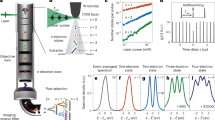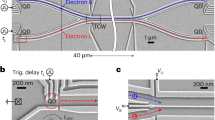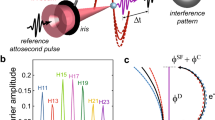Abstract
A series of recent experiments have shown that collision of ballistic electrons in semiconductors can be used to probe the indistinguishability of single-electron wavepackets. Perhaps surprisingly, their Coulomb interaction has not been seen due to screening. Here we show Coulomb-dominated collision of high-energy single electrons in counter-propagating ballistic edge states, probed by measuring partition statistics while adjusting the collision timing. Although some experimental data suggest antibunching behaviour, we show that this is not due to quantum statistics but to strong repulsive Coulomb interactions. This prevents the wavepacket overlap needed for fermionic exchange statistics but suggests new ways to utilize Coulomb interactions: microscopically isolated and time-resolved interactions between ballistic electrons can enable the use of the Coulomb interaction for high-speed sensing or gate operations on flying electron qubits.
This is a preview of subscription content, access via your institution
Access options
Access Nature and 54 other Nature Portfolio journals
Get Nature+, our best-value online-access subscription
$29.99 / 30 days
cancel any time
Subscribe to this journal
Receive 12 print issues and online access
$259.00 per year
only $21.58 per issue
Buy this article
- Purchase on Springer Link
- Instant access to full article PDF
Prices may be subject to local taxes which are calculated during checkout




Similar content being viewed by others
Data availability
The experimental data that support the findings of this study are available in the SEQUOIA community repository at https://zenodo.org/communities/sequoia/at https://doi.org/10.5281/zenodo.7643880. Calculation details are provided in Supplementary Information.
Code availability
The code used for analyses and figures is available from the corresponding author upon reasonable request.
References
Johnson, N. et al. Ultrafast voltage sampling using single-electron wavepackets. Appl. Phys. Lett. 110, 102105 (2017).
Zajac, D. M. et al. Resonantly driven CNOT gate for electron spins. Science 359, 439–442 (2018).
Bocquillon, E. et al. Coherence and indistinguishability of single electrons emitted by independent sources. Science 339, 1054–1057 (2013).
Jullien, T. et al. Quantum tomography of an electron. Nature 514, 603–607 (2014).
Bisognin, R. et al. Quantum tomography of electrical currents. Nat. Commun. 10, 3379 (2019).
Freulon, V. et al. Hong–Ou–Mandel experiment for temporal investigation of single-electron fractionalization. Nat. Commun. 6, 6854 (2015).
Fletcher, J. D. et al. Clock-controlled emission of single-electron wave packets in a solid-state circuit. Phys. Rev. Lett. 111, 216807 (2013).
Ubbelohde, N. et al. Partitioning of on-demand electron pairs. Nat. Nanotechnol. 10, 46–49 (2015).
Dubois, J. et al. Minimal-excitation states for electron quantum optics using levitons. Nature 502, 659–663 (2013).
Hong, C., Ou, Z. & Mandel, L. Measurement of subpicosecond time intervals between two photons by interference. Phys. Rev. Lett. 59, 2044 (1987).
Ferraro, D. et al. Real-time decoherence of Landau and Levitov quasiparticles in quantum Hall edge channels. Phys. Rev. Lett. 113, 166403 (2014).
Bellentani, L., Bordone, P., Oriols, X. & Bertoni, A. Coulomb and exchange interaction effects on the exact two-electron dynamics in the Hong–Ou–Mandel interferometer based on Hall edge states. Phys. Rev. B 99, 245415 (2019).
Pavlovska, E., Silvestrov, P. G., Recher, P., Barinovs, G. & Kashcheyevs, V. Collision of two interacting electrons on a mesoscopic beam splitter: Exact solution in the classical limit. Phys. Rev. B 107, 165304 (2023).
Ryu, S. & Sim, H.-S. Partition of two interacting electrons by a potential barrier. Phys. Rev. Lett. 129, 166801 (2022).
Bellentani, L., Forghieri, G., Bordone, P. & Bertoni, A. Two-electron selective coupling in an edge-state based conditional phase shifter. Phys. Rev. B 102, 035417 (2020).
Waldie, J. et al. Measurement and control of electron wave packets from a single-electron source. Phys. Rev. B 92, 125305 (2015).
Fletcher, J. D. et al. Continuous-variable tomography of solitary electrons. Nat. Commun. 10, 5298 (2019).
Giblin, S. P. et al. Towards a quantum representation of the ampere using single electron pumps. Nat. Commun. 3, 930 (2012).
Johnson, N. et al. LO-phonon emission rate of hot electrons from an on-demand single-electron source in a GaAs/AlGaAs heterostructure. Phys. Rev. Lett. 121, 137703 (2018).
Hassler, F., Lesovik, G. B. & Blatter, G. Effects of exchange symmetry on full counting statistics. Phys. Rev. Lett. 99, 076804 (2007).
Fertig, H. & Halperin, B. Transmission coefficient of an electron through a saddle-point potential in a magnetic field. Phys. Rev. B 36, 7969 (1987).
Skinner, B. & Shklovskii, B. I. Anomalously large capacitance of a plane capacitor with a two-dimensional electron gas. Phys. Rev. B 82, 155111 (2010).
Bocquillon, E. et al. Electron quantum optics in ballistic chiral conductors. Ann. Phys. (Berlin) 526, 1–30 (2014).
Duprez, H. et al. Macroscopic electron quantum coherence in a solid-state circuit. Phys. Rev. X 9, 021030 (2019).
Giblin, S. P. et al. Realisation of a quantum current standard at liquid helium temperature with sub-ppm reproducibility. Metrologia 57, 025013 (2020).
Leicht, C. et al. Generation of energy selective excitations in quantum hall edge states. Semicond. Sci. Technol. 26, 055010 (2011).
Kataoka, M. et al. Time-of-flight measurements of single-electron wave packets in quantum Hall edge states. Phys. Rev. Lett. 116, 126803 (2016).
Acknowledgements
We acknowledge experimental assistance from N. Johnson and S. Norimoto. We acknowledge use of software developed by F. Ahlers. W.P. and H.-S.S. acknowledge support by Korea NRF via the SRC Center for Quantum Coherence in Condensed Matter (grant number 2016R1A5A1008184 and RS-2023-00207732). This work was supported by the UK government’s Department for Business, Energy and Industrial Strategy and from the Joint Research Projects 17FUN04 SEQUOIA from the European Metrology Programme for Innovation and Research (EMPIR) co-financed by the participating states and from the European Union’s Horizon 2020 research and innovation programme. S.R. acknowledges support from the Maria de Maeztu Program for Units of Excellence number MDM2017-0711 funded by MCIN/AEI/10.13039/501100011033.
Author information
Authors and Affiliations
Contributions
J.D.F. designed and developed the measurement system and experimental methodology; with input from P.S. and M.K., designed samples; performed experiment, data acquisition and analysis; with W.P., helped to explore numerical calculation of particle trajectories and comparison with data. W.P. developed a method to calculate classical particle trajectories; performed numerical calculations to compare with experimental data; investigated methods to establish the validity of the classical model. S.R. developed a one-dimensional quantum collision model (published separately) and helped to develop a classical method of calculation of particle trajectories and advised on its realm of validity. P.S. developed fabrication techniques for electron pump devices; and fabricated samples used in this paper and preliminary batches of prototype electron colliders. J.P.G. and G.A.C.J. provided electron beam sample patterning. I.F. and D.A.R. provided wafers for the device substrates. H.-S.S. oversaw the development of both quantum and classical models of particle collision. M.K. directed this research project; supported J.D.F. for experiments and data analysis, and suggested the underpinning mechanisms that result in positive and negative correlation in two-electron transmission/reflection observed experimentally. The manuscript was written by J.D.F., M.K., W.P., S.R. and H.-S.S. with review by other authors.
Corresponding authors
Ethics declarations
Competing interests
The authors declare no competing interests.
Peer review
Peer review information
Nature Nanotechnology thanks Christian Flindt and the other, anonymous, reviewer(s) for their contribution to the peer review of this work.
Additional information
Publisher’s note Springer Nature remains neutral with regard to jurisdictional claims in published maps and institutional affiliations.
Supplementary information
Supplementary Information
Theoretical and experimental details.
Rights and permissions
Springer Nature or its licensor (e.g. a society or other partner) holds exclusive rights to this article under a publishing agreement with the author(s) or other rightsholder(s); author self-archiving of the accepted manuscript version of this article is solely governed by the terms of such publishing agreement and applicable law.
About this article
Cite this article
Fletcher, J.D., Park, W., Ryu, S. et al. Time-resolved Coulomb collision of single electrons. Nat. Nanotechnol. 18, 727–732 (2023). https://doi.org/10.1038/s41565-023-01369-4
Received:
Accepted:
Published:
Issue Date:
DOI: https://doi.org/10.1038/s41565-023-01369-4
This article is cited by
-
Interacting electrons collide at a beam splitter
Nature Nanotechnology (2023)



